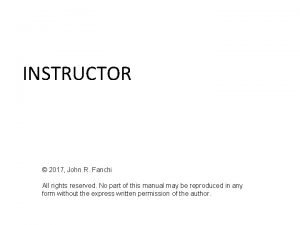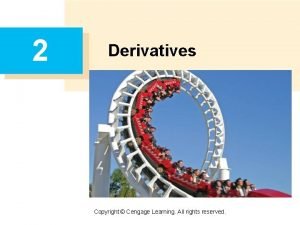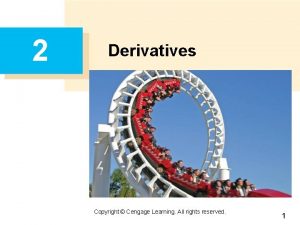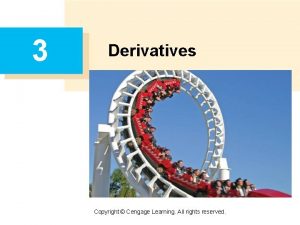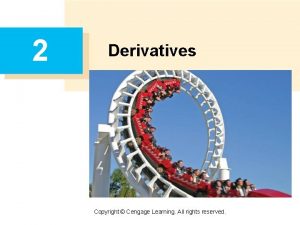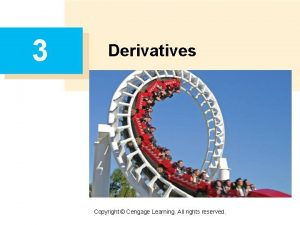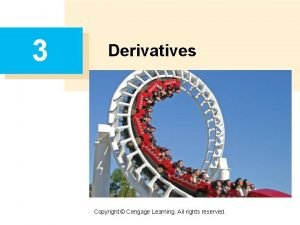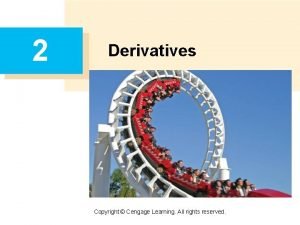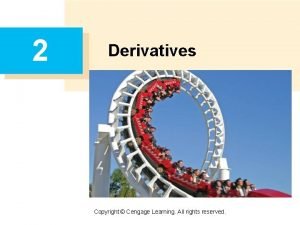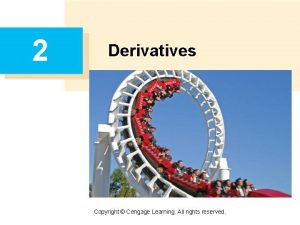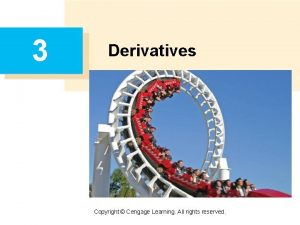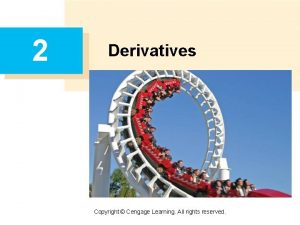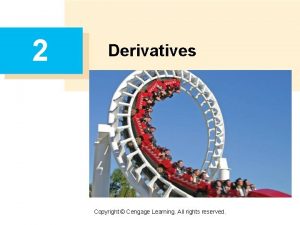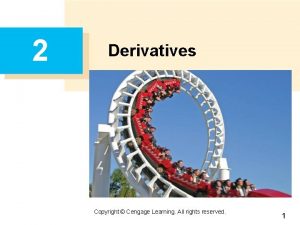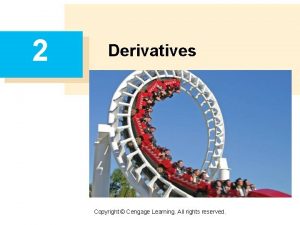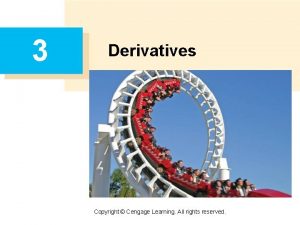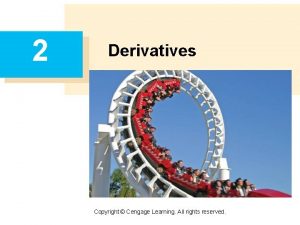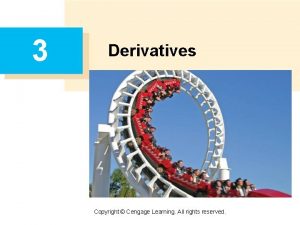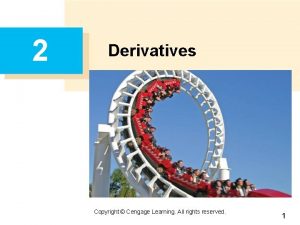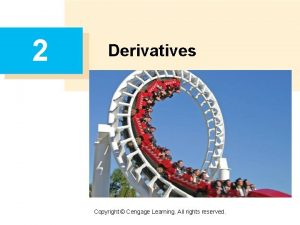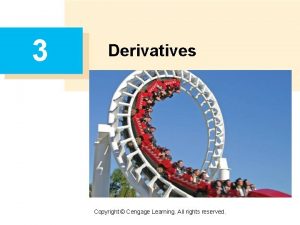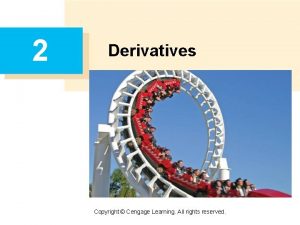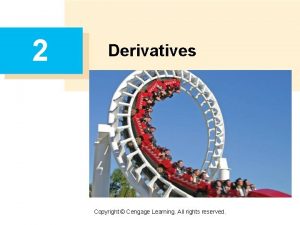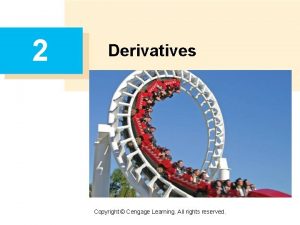2 Derivatives Copyright Cengage Learning All rights reserved








































- Slides: 40

2 Derivatives Copyright © Cengage Learning. All rights reserved.

2. 1 Derivatives and Rates of Change Copyright © Cengage Learning. All rights reserved.

Derivatives and Rates of Change The problem of finding the tangent line to a curve and the problem of finding the velocity of an object both involve finding the same type of limit. This special type of limit is called a derivative and we will see that it can be interpreted as a rate of change in any of the sciences or engineering. 3

Tangents 4

Tangents If a curve C has equation y = f (x) and we want to find the tangent line to C at the point P (a, f (a)), then we consider a nearby point Q (x, f (x)), where x a, and compute the slope of the secant line PQ: Then we let Q approach P along the curve C by letting x approach a. 5

Tangents If m. PQ approaches a number m, then we define the tangent t to be the line through P with slope m. (This amounts to saying that the tangent line is the limiting position of the secant line PQ as Q approaches P. See Figure 1. ) Figure 1 6

Tangents 7

Example 1 Find an equation of the tangent line to the parabola y = x 2 at the point P(1, 1). Solution: Here we have a = 1 and f (x) = x 2, so the slope is 8

Example 1 – Solution cont’d Using the point-slope form of the equation of a line, we find that an equation of the tangent line at (1, 1) is y – 1 = 2(x – 1) or y = 2 x – 1 9

Tangents We sometimes refer to the slope of the tangent line to a curve at a point as the slope of the curve at the point. The idea is that if we zoom in far enough toward the point, the curve looks almost like a straight line. Figure 2 illustrates this procedure for the curve y = x 2 in Example 1. Zooming in toward the point (1, 1) on the parabola y = x 2 Figure 2 10

Tangents The more we zoom in, the more the parabola looks like a line. In other words, the curve becomes almost indistinguishable from its tangent line. There is another expression for the slope of a tangent line that is sometimes easier to use. 11

Tangents If h = x – a, then x = a + h and so the slope of the secant line PQ is (See Figure 3 where the case h > 0 is illustrated and Q is to the right of P. If it happened that h < 0, however, Q would be to the left of P. ) Figure 3 12

Tangents Notice that as x approaches a, h approaches 0 (because h = x – a) and so the expression for the slope of the tangent line in Definition 1 becomes 13

Velocities 14

Velocities In general, suppose an object moves along a straight line according to an equation of motion s = f (t), where s is the displacement (directed distance) of the object from the origin at time t. The function f that describes the motion is called the position function of the object. In the time interval from t = a to t = a + h the change in position is f (a + h) – f (a). (See Figure 5. ) Figure 5 15

Velocities The average velocity over this time interval is 16

Velocities which is the same as the slope of the secant line PQ in Figure 6 17

Velocities Now suppose we compute the average velocities over shorter and shorter time intervals [a, a + h]. In other words, we let h approach 0. As in the example of the falling ball, we define the velocity (or instantaneous velocity) v (a) at time t = a to be the limit of these average velocities: This means that the velocity at time t = a is equal to the slope of the tangent line at P. 18

Example 3 Suppose that a ball is dropped from the upper observation deck of the CN Tower, 450 m above the ground. (a) What is the velocity of the ball after 5 seconds? (b) How fast is the ball traveling when it hits the ground? Solution: We will need to find the velocity both when t = 5 and when the ball hits the ground, so it’s efficient to start by finding the velocity at a general time t = a. 19

Example 3 – Solution cont’d Using the equation of motion s = f (t) = 4. 9 t 2, we have 20

Example 3 – Solution cont’d (a) The velocity after 5 s is v(5) = (9. 8)(5) = 49 m/s. (b) Since the observation deck is 450 m above the ground, the ball will hit the ground at the time t 1 when s(t 1) = 450, that is, 4. 9 t 12 = 450 This gives t 12 = and t 1 = 9. 6 s The velocity of the ball as it hits the ground is therefore v(t 1) = 9. 8 t 1 = 9. 8 94 m/s 21

Derivatives 22

Derivatives We have seen that the same type of limit arises in finding the slope of a tangent line (Equation 2) or the velocity of an object (Equation 3). In fact, limits of the form arise whenever we calculate a rate of change in any of the sciences or engineering, such as a rate of reaction in chemistry or a marginal cost in economics. Since this type of limit occurs so widely, it is given a special name and notation. 23

Derivatives If we write x = a + h, then we have h = x – a and h approaches 0 if and only if x approaches a. Therefore an equivalent way of stating the definition of the derivative, as we saw in finding tangent lines, is 24

Example 4 Find the derivative of the function f (x) = x 2 – 8 x + 9 at the number a. Solution: From Definition 4 we have 25

Example 4 – Solution cont’d 26

Derivatives We defined the tangent line to the curve y = f (x) at the point P (a, f (a)) to be the line that passes through P and has slope m given by Equation 1 or 2. Since, by Definition 4, this is the same as the derivative f (a), we can now say the following. 27

Derivatives If we use the point-slope form of the equation of a line, we can write an equation of the tangent line to the curve y = f (x) at the point (a, f (a)): y – f (a) = f (a)(x – a) 28

Rates of Change 29

Rates of Change Suppose y is a quantity that depends on another quantity x. Thus y is a function of x and we write y = f (x). If x changes from x 1 to x 2, then the change in x (also called the increment of x) is x = x 2 – x 1 and the corresponding change in y is y = f (x 2) – f (x 1) 30

Rates of Change The difference quotient is called the average rate of change of y with respect to x over the interval [x 1, x 2] and can be interpreted as the slope of the secant line PQ in Figure 8 31

Rates of Change By analogy with velocity, we consider the average rate of change over smaller and smaller intervals by letting x 2 approach x 1 and therefore letting Δx approach 0. The limit of these average rates of change is called the (instantaneous) rate of change of y with respect to x at x = x 1, which is interpreted as the slope of the tangent to the curve y = f (x) at P(x 1, f (x 1)): We recognize this limit as being the derivative f (x 1). 32

Rates of Change We know that one interpretation of the derivative f (a) is as the slope of the tangent line to the curve y = f (x) when x = a. We now have a second interpretation: The connection with the first interpretation is that if we sketch the curve y = f (x), then the instantaneous rate of change is the slope of the tangent to this curve at the point where x = a. 33

Rates of Change This means that when the derivative is large (and therefore the curve is steep, as at the point P in Figure 9), the y-values change rapidly. Figure 9 The y-values are changing rapidly at P and slowly at Q. 34

Rates of Change When the derivative is small, the curve is relatively flat (as at point Q) and the y-values change slowly. In particular, if s = f (t) is the position function of a particle that moves along a straight line, then f (a) is the rate of change of the displacement s with respect to the time t. In other words, f (a) is the velocity of the particle at time t = a. The speed of the particle is the absolute value of the velocity, that is, | f (a) |. 35

Example 6 A manufacturer produces bolts of a fabric with a fixed width. The cost of producing x yards of this fabric is C = f (x) dollars. (a) What is the meaning of the derivative f (x)? What are its units? (b) In practical terms, what does it mean to say that f (1000) = 9? (c) Which do you think is greater, f (50) or f (500)? What about f (5000)? 36

Example 6(a) – Solution The derivative f (x) is the instantaneous rate of change of C with respect to x; that is, f (x) means the rate of change of the production cost with respect to the number of yards produced. Because the units for f (x) are the same as the units for the difference quotient C/ x. Since C is measured in dollars and x in yards, it follows that the units for f (x) are dollars per yard. 37

Example 6(b) – Solution cont’d The statement that f (1000) = 9 means that, after 1000 yards of fabric have been manufactured, the rate at which the production cost is increasing is $9/yard. (When x = 1000, C is increasing 9 times as fast as x. ) Since x = 1 is small compared with x = 1000, we could use the approximation and say that the cost of manufacturing the 1000 th yard (or the 1001 st) is about $9. 38

Example 6(c) – Solution cont’d The rate at which the production cost is increasing (per yard) is probably lower when x = 500 than when x = 50 (the cost of making the 500 th yard is less than the cost of the 50 th yard) because of economies of scale. (The manufacturer makes more efficient use of the fixed costs of production. ) So f (50) > f (500) 39

Example 6(c) – Solution cont’d But, as production expands, the resulting large-scale operation might become inefficient and there might be overtime costs. Thus it is possible that the rate of increase of costs will eventually start to rise. So it may happen that f (5000) > f (500) 40
 Copyright 2015 all rights reserved
Copyright 2015 all rights reserved Copyright © 2015 all rights reserved
Copyright © 2015 all rights reserved Dell all rights reserved copyright 2009
Dell all rights reserved copyright 2009 Copyright © 2018 all rights reserved
Copyright © 2018 all rights reserved Copyright cengage learning. powered by cognero
Copyright cengage learning. powered by cognero All rights reserved example
All rights reserved example All rights reserved sentence
All rights reserved sentence Creative commons vs all rights reserved
Creative commons vs all rights reserved Confidential all rights reserved
Confidential all rights reserved Sentinel repetition
Sentinel repetition Pearson education inc all rights reserved
Pearson education inc all rights reserved Microsoft corporation. all rights reserved.
Microsoft corporation. all rights reserved. Microsoft corporation. all rights reserved
Microsoft corporation. all rights reserved Microsoft corporation. all rights reserved.
Microsoft corporation. all rights reserved. Pearson education inc. all rights reserved
Pearson education inc. all rights reserved Warning all rights reserved
Warning all rights reserved Siprop
Siprop Quadratic equation cengage
Quadratic equation cengage Warning all rights reserved
Warning all rights reserved Confidential all rights reserved
Confidential all rights reserved Microsoft corporation. all rights reserved
Microsoft corporation. all rights reserved 2010 pearson education inc
2010 pearson education inc 2017 all rights reserved
2017 all rights reserved Copyright 2010 pearson education inc
Copyright 2010 pearson education inc 2010 pearson education inc
2010 pearson education inc Confidential all rights reserved
Confidential all rights reserved Airbus deutschland gmbh
Airbus deutschland gmbh R rights reserved
R rights reserved Rights reserved
Rights reserved 2009 delmar cengage learning
2009 delmar cengage learning Cengage chapter 5
Cengage chapter 5 Cengage learning heart diagram
Cengage learning heart diagram South-western cengage learning
South-western cengage learning Chapter 13 medical math
Chapter 13 medical math 2009 delmar cengage learning
2009 delmar cengage learning Cengage learning heart diagram
Cengage learning heart diagram Introduction to medical terminology chapter 1
Introduction to medical terminology chapter 1 Cengage learning australia
Cengage learning australia 2009 delmar cengage learning
2009 delmar cengage learning Whille
Whille Cengage learning
Cengage learning



























